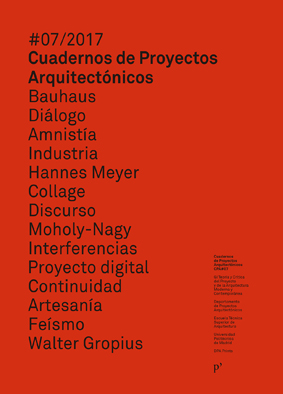Half a Century of Liberation: From Objectivity to Amnesty
Parole chiave:
Objetivity, Amnesty, Permissiveness, Judgment, OrdinaryAbstract
Abstract
Amnesty for Constructed Reality, 1978, is the synthesis of the action taken by Haus-Rucker-Co. Laurids Ortner recovered the ideas of New Objectivity to defend the entire existing urban landscape: “The debate about our built environment has become primarily a problem of aesthetic judgment. They are criteria for visual perception which concern us much more than the actual physical risk factors. What is usually seen as our environment is characterized by adjectives that, according to their level of sophistication, ranging from emotionally charged words like ugly, sad and chaotic the so-called objective terms as inaccessible and monotonous.”
Haus-Rucker-Co Manifesto continues a key line of thought in both artistic and architectural practice during the middle decades of the 20th century: “a profoundly liberating attitude that allowed finding value in places and objects usually judged as ugly by architects.” These words by Scott Brown justify movements often considered opposites. From “industrial” early Modern to “commercial” postmodern, the invocation of objectivity and suppression of judgment have served as major theoretical arguments. If, during the 1920s the principles of the Neue Sachlichkeit served as the basis for a reaction against German Expressionism, the recovery by Alison and Peter Smithson in England in the fifties would be used by Venturi and Scott Brown as a starting point for his theories of non-prosecution.
As critics denounced (Lootsma, Koetter, Frampton ...) the problem of this “permissive” attitude –if we use the term introduced by Scott Brown as a principle– lies in the danger of falling into resignation. This uncritical attitude, wrapped in values of respect, eliminates the socio-political consciousness of the architect and risks falling into the immediacy of understanding the amnestied object directly as a model.
Downloads
Riferimenti bibliografici
ALLOWAY, Lawrence: City Notes. En Architectural Design, enero de 1959.
BANHAM, Rener; PRICE, Cedric; BARKER, Paul; HALL, Peter: Non-Plan: An Experiment in Freedom. En New society, 338, V. 13, 1969.
FRAMPTON, Kenneth: Architecture, a Critical History. Thames & Hudson Ed., London, 1980.
GODFINGER, Ernö; CARTER, E.J: The County of London Plan. Penguin Books Ed., London, 1945.
HOLLEIN, Hans: Alles ist architektur. En Bau, 1-2, 1968.
KOETHER, Fred: On Robert Venturi, Denise Scott Brown and Steven Izenour´s Learning from Las Vegas. En Oppositions, 3, mayo, 1974.
KEYNES, John Maynard: Carta dirigida a Friedrich Hayek, 28 de Junio de, 1944. En John Maynard Keynes, Activities 1940–1946. Shaping the Post-War World: Employment and Commodities, The Collected Writings of John Maynard Keynes, V. 27, Macmillan Ed., London, 1980.
LISSITZKY, El: Proun Room: Grosse Berliner Kunstausstellung, 1923. En G, 1, julio, 1923.
LOOS, Adolf. Von einem armen, reichen Mann. En Neues Wiener Tablatt, Viena, 26 de abril de 1900.
MUÑOZ, María Teresa: La desintegración estilística de la arquitectura contemporánea. Ediciones asimétricas Ed., Madrid, 2012. Tesis doctoral, DPA, ETSAM, UPM, Madrid, 1982.
ORTNER, Laurids: Amnestie für die gebaute Realität. En Werk Archithese, V. 17-18, 65, 1978.
SCOTT BROWN, Denise; VENTURI, Robert: Aprendiendo de todas las cosas. Tusquets Ed., Barcelona, 1971.
SCOTT BROWN, Denise: Learning from Brutalism. En The Independent group. Postwar Britain and the aesthetics of Plenty, The MIT Press Ed., Cambridge, 1990.
SMITHSON, Peter: Letter to America. En Architectural Design, 28, Marzo, 1958.
SMITHSON, Alison; SMITHSON, Peter: But Today We Collect Ads. En Ark, 18, Noviembre, 1956.
SMITHSON, Alison; SMITHSON, Peter: The As found and the Found. En The Independent Group Postwar Britain or the aesthetics of Plenty, The MIT Press Ed., Cambridge, 1990.
VENTURI, Robert: The Campidoglio: a case study. En Architectural Review, 113, mayo, 1953.
VENTURI, Robert: Complexity and Contradiction in Architecture. Moma Press Ed., Nueva York, 1966.
VVAA: Man-made America. Architectural Review, 648, V. 108, Diciembre, 1950.
Dowloads
Pubblicato
Fascicolo
Sezione
Licenza
1. Los autores conservan los derechos de autor y garantizan a la revista el derecho de una Licencia Creative Commons Atribución-NoComercial-SinDerivar 4.0 Internacional que permite a otros compartir el trabajo con un reconocimiento de la autoría.
2. Los autores pueden establecer por separado acuerdos adicionales para la distribución no exclusiva de la versión de la obra publicada en la revista (por ejemplo, situarlo en un repositorio institucional o publicarlo en un libro).












